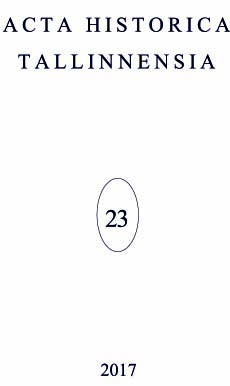RAHVUSVAHELISE TÖÖORGANISATSIOONI
1928. AASTA KONVENTSIOON NR 26 MIINIMUMPALGA KINDLAKSMÄÄRAMISE MEETODITE KOHTA JA EESTI
THE MINIMUM WAGE-FIXING MACHINERY CONVENTION, 1928 (NO. 26) OF THE INTERNATIONAL LABOUR ORGANIZATION
AND ESTONIA
Author(s): Maie PihlamägiSubject(s): History, Economic history, Labor relations, Interwar Period (1920 - 1939)
Published by: Teaduste Akadeemia Kirjastus
Summary/Abstract: This article deals with the International Labour Organization (ILO) convention of 1928 on minimum wage-fixing machinery, aimed at guaranteeing employees in industry and commerce reasonable wages to meet their basic needs. Also the reasons why Estonia did not join the Convention and the role of the ILO in the development of Estonian national wage policy are under consideration.In 1919, when the ILO was established, minimum wages had only been set in a few countries. The principle that the wage paid to an employee should be adequate to guarantee a reasonable standard of living for them became the guiding principle of the policy of the ILO. After several years of preparation, the issue of fixing minimum wages was for the first time on the agenda of the session of the ILO Conference in 1927. This resulted in the adoption of a questionnaire on Minimum Wage-Fixing Machinery. The discussion on this matter based on the answers to the questionnaire continued at the ILO 1928 conference, where the Minimum Wage-Fixing Machinery Convention (No. 26) and Recommendation were adopted. The main aim of the convention was to oblige the ILO Member States to maintain or create a machinery whereby minimum rates of wages could be fixed for workers employed in industry and commerce and in particular in home-working trades in which no arrangements existed for the effective regulation of wages by collective agreement or otherwise and waged were exceptionally low.Many Member States, including Estonia, did not ratify this convention. Among the various reasons there was the prevailing opinion that the issue of minimum wages was a topic to be solved internally. Estonian employers strongly opposed the Convention arguing that they had no possibilities of raising the wages because the growth of Estonian economy did not support a rise in wages and fixing minimum wages. They ignored the fact that a set minimum wage would help the economy in a number of ways.Because the national minimum wage was not established by law and was mostly not determined by collective agreements as the practice of concluding collective agreements was still in its infancy in Estonia, the workers’ wages were generally determined unilaterally by the employers. However, the influence of the ILO in the development of minimum wages is worth stressing. The Estonian ministries responsible for social policy had several times drawn up a draft of the national law on the minimum wage. Although the draft was discussed in the Parliament, it never became the law because of strong resistance from employers. However, the attitude of employers toward the implementation of minimum wages changed when the Labour Dispute Committee was created in 1935 to prevent a strike. The decisions of the Labour Dispute Committee to increase the workers’ wages were compulsory for entrepreneurs. A rise in the workers’ wage level was accompanied by a rise of the production costs, which negatively influenced a company’s competitive position compared to other companies in the same industry where the wage level was lower and the workers did not go on strike. As a result of increased competition, employers, in particular in the most important industrial branch – the textile industry, became supporters of introducing a minimum wage. However, instead of the central approach they preferred to negotiate with workers and to reach a voluntary agreement on minimum wages. The textile industry considered the introduction of minimum wages by region and by sector to be positive. Nevertheless, the new regional wage system developed by textile industrialists was not implemented due to the outbreak of World War II.
Journal: Acta Historica Tallinnensia
- Issue Year: 2017
- Issue No: 23
- Page Range: 97-112
- Page Count: 16
- Language: Estonian

